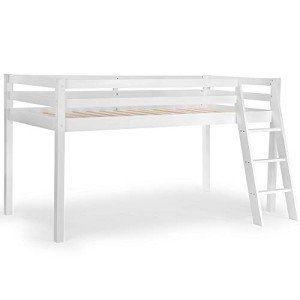A Comprehensive Guide to Children's Bunk Beds: Styles, Benefits, and Safety Considerations
Bunk beds have actually ended up being a popular option for households wanting to take full advantage of space and supply a fun sleeping environment for children. With their special style, they use an innovative and useful option for shared bed rooms, playrooms, and even guest lodging. Bunk Bed For Adults out the various styles of children's bunk beds, their advantages, security considerations, and addresses some frequently asked concerns.
The Allure of Bunk Beds
Children's bunk beds are more than simply space-saving structures; they are also a gateway to daring dreams and imaginative play. Below is an in-depth assessment of their numerous advantages.
Benefits of Bunk Beds
- Space-Saving: Bunk beds efficiently use vertical space, making them a perfect option for smaller spaces.
- Lively Design: Many bunk bed designs consist of slides, camping tents, and themed elements, triggering imagination and excitement.
- Partner Sharing: Bunk beds are perfect for siblings sharing a room or accommodating pajama parties.
- Versatile Use: Some designs can be separated into two individual beds, using versatility as kids grow.
- Storage Options: Many bunk beds include built-in drawer storage or racks, further improving their usefulness.
Designs of Children's Bunk Beds
The range of bunk beds readily available today accommodates different choices and needs. Below is a summary of some popular styles.
| Style | Description | Best For |
|---|---|---|
| Requirement Bunk Bed | A standard design including one bed stacked above another. | Siblings sharing a room. |
| Loft Bed | Similar to a bunk bed without the bottom bunk, allows for an office or play area below. | Limited space for play/desk. |
| L-Shaped Bunk Bed | Two beds set up in an L-shape, typically with extra areas for storage or play. | Distinct space designs. |
| Twin Over Full | A twin bed over a complete bed, accommodating different sleep needs. | Growing children and teens. |
| High Sleeper | Stands even greater than a loft bed, normally featuring a desk or play area below. | Older kids needing more play/desk space. |
| Camping Tent Bunk Bed | Bunk beds with a canopy or tent-like structure, creating a comfortable, fun space. | Active and imaginative children. |
Secret Features to Consider
When choosing the best bunk bed for children, the following features deserve considering:
- Material: Bunk beds can be made from wood, metal, or a mix. Each has its unique visual and toughness.
- Weight Capacity: Always confirm the weight limitation of the bunk bed to ensure it can accommodate your kids safely.
- Safety Rails: Ensure the leading bunk has strong rails to avoid falls.
- Ladder Security: A well-designed ladder needs to offer simple and safe access to the upper bunk.
- Ending up: Ensure any finishes are non-toxic and safe for children.
Security Considerations
Safety is vital when it comes to kids's bunk beds. The following guidelines must be complied with:
- Age Appropriateness: Generally, kids under six years old should not sleep in the upper bunk due to safety threats.
- Durable Construction: Ensure the frame and products are solid and can support the weight without sagging.
- Routine Maintenance: Periodically look for loose screws, bolts, or other components that might need tightening.
- Clear Play Area: Keep the area around the bunk bed devoid of toys and challenges to decrease tripping dangers.
Setting Rules for Safe Use
Establishing standards for bunk bed usage will assist guarantee safety:
- Limit Jumping and Climbing: Children ought to be encouraged against leaping from the top bunk and climbing up on the sides.
- Monitoring Sleepovers: Monitor young visitors while they are utilizing the bunk bed for the first time.
- Educate on Ladder Use: Teach how to use the ladder securely, emphasizing the importance of facing the ladder when going up or down.
Often Asked Questions
1. What age is appropriate for a child to oversleep the leading bunk?
A lot of manufacturers suggest that kids must be at least six years old to oversleep the upper bunk. This standard is designed to reduce the risk of falls.
2. Can bunk beds be customized?
Yes, lots of manufacturers use personalized alternatives, including colors, products, and additional functions like drawers or desks.
3. Are bunk beds safe for weight?
Bunk beds have weight limits, normally ranging from 200 to 400 pounds, depending on the design and product. Constantly inspect the manufacturer's specifications.
4. How do I maintain and clean a bunk bed?
Routinely look for loose parts, keep the bed clean by wiping down surfaces, and ensure the bed linen is fresh to promote a safe and hygienic sleep environment.
5. Can bunk beds be separated into individual beds?
Lots of bunk beds come with a choice to separate them into two individual beds, providing long-term versatility.
Kid's bunk beds are more than mere furnishings; they are a practical, flexible, and imaginative element of a child's space. With various styles available and numerous safety factors to consider to bear in mind, moms and dads can select the ideal bed that fits their space, satisfies their kids's needs, and instills a sense of experience. By understanding the advantages, styles, and precaution associated with bunk beds, households can create a wonderful and safe sleeping environment for their children. Whether for brother or sisters sharing a room or space-saving solutions, bunk beds remain a precious option for lots of homes.

